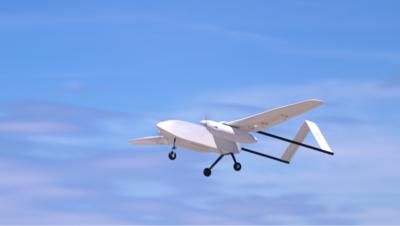Fri, Nov 25, 2022
Self-Contained Hydrogen Engine Nacelle May Be Offered as UAV Aftermarket Modification
H3 Dynamics' twin-engine hydrogen UAV demonstrator completed its first successful test flight over a Paris airfield.

The flight was a capstone of sorts, for a program that first completed a working propulsion nacelle prototype a year prior. By July, H3 Dynamics had been able to test their first distributed pod system on a scale aircraft at the Hub Drones - Systematic airfield near Paris, France. That proved the basic functionality of their hydrogen-powered system, allowing them to begin scaling up their designs. The most recent test evaluated the performance of a twin-engine, hydrogen powered, propeller-driven propulsion aircraft on the way towards larger, more complex installations. While H3 Dynamics will need to continue their progress flying small, uncrewed aircraft, the company eagerly looks to the future, with plans for bigger and better hydrogen aircraft converted from existing makes and models. With the successful demonstration of a twin-engine platform, the company says it will soon tackle a 6-engine aircraft in the same vein.
The uncrewed twin-engine test aircraft boasts a 900 km range on liquid hydrogen, stored entirely in its wing-mounted nacelles. That external mounting allows for safer, less anxiety-inducing carriage of super-flammable hydrogen fuel in addition to maximizing interior cargo storage. Should the demonstrator be powered with pressurized hydrogen, its range drops to 350 km, still quite passable given the aircraft's 30-liter interior volume. H3 Dynamics sees their standalone hydrogen nacelle design as a perfect candidate for aftermarket installation and retrofitment, an easy way to bolster the power of any small aircraft with sustainable, on-demand thrust. The compact size should mean the self-contained hydrogen nacelles can quickly be developed into a snap-on addition to existing eVTOL or fixed wing cargo drones.
“Not only is safety our first priority, but we don’t want hydrogen competing for revenue-generating air freight and passenger space,” said Taras Wankewycz, CEO of H3 Dynamics. As outlined by the company's hydrogen developers, distribution of hydrogen power is key. Spreading the hydrogen propulsion systems allows for more efficient thermal management, increased redundancy, and simpler installation.
H3 Dynamics made mention of their plan to complete an Atlantic crossing on hydrogen-electric hybrid propulsion in the next 2 years, proving the feasibility of liquid h2 power with partner ISAE-SUPAERO.
More News
From 2023 (YouTube Edition): An Even Faster Rolling Extra! Jim Campbell joined General Manager of Extra Aircraft Duncan Koerbel at AirVenture 2023 to talk about what’s up and>[...]
“Receiving our Permit to Fly and starting Phase 4 marks a defining moment for Vertical Aerospace. Our team has spent months verifying every core system under close regulatory>[...]
Middle Marker A marker beacon that defines a point along the glideslope of an ILS normally located at or near the point of decision height (ILS Category I). It is keyed to transmit>[...]
The Experienced Pilot Chose To Operate In Instrument Meteorological Conditions Without An Instrument Flight Rules Clearance Analysis: The airplane was operated on a personal cross->[...]
Also: ATI Strike Prep, Spirit Still Troubled, New CubCrafters Dealership, A-29 Super Tucano Samaritan’s Purse is officially moving its historic Douglas DC-8 cargo jet into re>[...]
 Classic Aero-TV: Extra Aircraft Announces the Extra 330SX
Classic Aero-TV: Extra Aircraft Announces the Extra 330SX Aero-News: Quote of the Day (11.15.25)
Aero-News: Quote of the Day (11.15.25) ANN's Daily Aero-Term (11.15.25): Middle Marker
ANN's Daily Aero-Term (11.15.25): Middle Marker NTSB Final Report: Lancair 320
NTSB Final Report: Lancair 320 Airborne 11.14.25: Last DC-8 Retires, Boeing Recovery, Teeny Trig TXP
Airborne 11.14.25: Last DC-8 Retires, Boeing Recovery, Teeny Trig TXP



